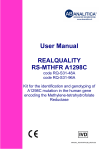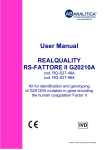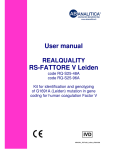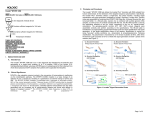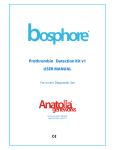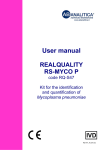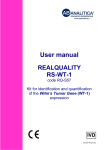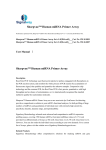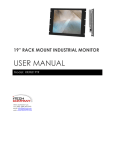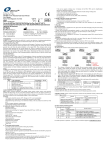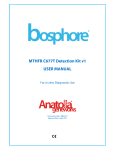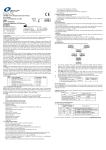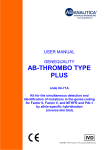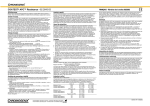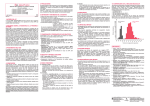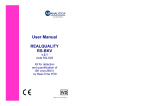Download User Manual
Transcript
User Manual REALQUALITY RS-MTHFR C677T code RQ-S29-48A code RQ-S29-96A Kit for the identification and genotyping of C677T mutation in the human gene encoding the Methylene-tetrahydrofolate Reductase MANUAL_RS-MTHFR677_eR070109 This product was developed using a technology licenced by: DxS Ltd, Manchester (UK) 1 PRODUCT INFORMATION 3 1.1 3 Intended Use 2 KIT CONTENT 4 3 STORAGE AND STABILITY OF THE REAGENTS 5 4 PRECAUTIONS FOR USE 5 5 SAFETY RULES 6 5.1 General safety rules 6 5.2 Safety rules about the kit 7 6 MATERIALS REQUIRED, BUT NOT PROVIDED 8 6.1 Reagents 8 6.2 Instruments 8 6.3 Materials 8 7 INTRODUCTION 9 8 TEST PRINCIPLE 11 9 PRODUCT DESCRIPTION 12 10 COLLECTION, MANIPULATION AND PRE-TREATMENT OF THE SAMPLES 13 10.1 13 Peripheral blood 11 PROTOCOL 13 11.1 13 DNA Extraction 11.2 DNA Amplification 11.2.1 Instrument programming 11.2.2 Amplification Mix preparation 11.2.3 Pre-Read run 11.2.4 Absolute Quantification run 11.2.5 Post-Read run 14 14 17 18 18 19 11.3 19 Data analysis 12 TROUBLESHOOTING 23 1 MANUAL_RS-MTHFR677_eR070109 13 DEVICE LIMITATIONS 25 14 DEVICE PERFORMANCES 25 14.1 Analytical specificity 25 14.2 Diagnostic sensitivity and specificity 25 14.3 Analytical sensitivity 25 14.4 Accuracy 26 15 REFERENCES 27 16 RELATED PRODUCTS 28 MANUAL_RS-MTHFR677_eR070109 2 1 PRODUCT INFORMATION 1.1 Intended Use The RS-MTHFR C677T kit is an IVD for identification and genotyping of C677T mutation in gene encoding the human Methylene-tetrahydrofolate Reductase, by means of Real time PCR amplification of genomic DNA extracted from human peripheral blood. It is an in vitro diagnostic test for detection and genotyping of MTHFR mutation, and it represents an auxiliary instrument for diagnosis and evaluation of putative thrombophylic patients. As such, it is recommended to use this kit as indicated in the instructions herein. The present manual refers to the following product: RS-MTHFR C677T: Kit for identification and genotyping of C677T mutation in gene encoding the human Methylene-tetrahydrofolate Reductase, by Real time PCR amplification. Contains all the reagents needed for the Real time amplification. This product is in accordance with 98/79/CE Directive regarding the In Vitro medical diagnostic devices (CE mark). Code RQ-S29-48A RQ-S29-96A Product RS-MTHFR C677T RS-MTHFR C677T PKG 48 reactions 96 reactions NOTE: The product was validated on ABI 7300 (Applied Biosystems). The compatibility with the ABI7000 (Applied Biosystems) and SmartCycler (Cepheid-Celbio) instruments was confirmed experimentally). 3 MANUAL_RS-MTHFR677_eR070109 2 KIT CONTENT BOX F* STORE AT – 30°/ @20°C DESCRIPTION Mastermix 2X Primer and probe Mix Passive Reference TUBE (T) OR LID COLOUR LABEL 2X AD Real Time Mix Oligomix MTHFR C677T White ROX 96 React. 48 React. 24 React. 4 x 340 µL 2 x 340 µL 1 x 340 µL 4 x 27 µL 2 x 27 µL 1 x 24 µL 2 x 30 µL 1 x 30 µL 1 x 15 µL BAG STORE AT + 2°/+ 8°C DESCRIPTION DNA containing a part of the target sequence, wild type homozygote for MTHFR C677T Mix of HOMO WT and HOMO MUT positive controls for MTHFR C677T DNA containing a part of the target sequence, mutant homozygote for MTHFR C677T MANUAL_RS-MTHFR677_eR070109 LABEL TUBE (T) OR LID COLOUR 96 React. 48 React. 24 React. HOMO WT MTHFR C677T Positive control Blue 1 x 20 µL 1 x 10 µL 1 x 10 µL HET MTHFR C677T Positive control Green 1 x 20 µL 1 x 10 µL 1 x 10 µL HOMO MUT MTHFR C677T Positive control Red 1 x 20 µL 1 x 10 µL 1 x 10 µL 4 3 STORAGE AND STABILITY OF THE REAGENTS Each component of the kit should be stored according to the directions indicated on the label of the single boxes. In particular: Box F* BAG store at -30°C/-20°C store at +2/+8°C When stored at the recommended temperature, all test reagents are stable until their expiration date. The 2X AD Real Time Mix, Oligomix and the positive control reagents are sensitive to the physical state variations: it is recommended not to let the reagents undergo more than two freeze/thaw cycles. If the single test runs are limited to a small number of samples, it is recommended to aliquot the reagents. Oligomix and ROX contain fluorescent molecules: it is recommended to store these reagents far from any light source. 4 PRECAUTIONS FOR USE • The kit must be used only as an IVD and handled by qualified investigators, who are educated and trained in molecular biology techniques applied to diagnostics; • Before starting the kit procedure, read carefully and completely the instruction manual; • Keep the product away from heating sources and the direct light; • Do not use any part of the kit if over the expiration date; In case of any doubt about the storage conditions, box integrity or method application, contact AB ANALITICA technical support at: [email protected] 5 MANUAL_RS-MTHFR677_eR070109 In the amplification of nucleic acids, the investigator has to take the following special precautions: • Use filter-tips; • Store the biological samples, the extracted DNA, positive control included in the kit and all the amplification products in different places from where amplification reagents are stored; • Organise the work space in different pre- and post-PCR units; do not share consumables (pipettes, tips, tubes, etc) between them; • Change the gloves frequently; • Wash the bench surfaces with 5% sodium hypochloride; • Thaw the reagents prior to use; once thawed, mix the solutions well by inverting the tubes several times (do not vortex!), then centrifuge briefly; • Prepare the reaction mix rapidly at the room temperature or work on ice or on the cooling block. 5 SAFETY RULES 5.1 General safety rules • Wear disposable gloves to handle the reagents and the clinical samples and wash the hands at the end of work; • Since no known diagnostic method can assure the absence of infective agents, it is a good rule to consider every clinical sample as potentially infectious and handle it as such; • All the devices that get directly in touch with clinical samples should be considered as contaminated and disposed as such. In case of accidental spilling of the samples, clean up with 10% Sodium Hypochloride. The materials used to clean up should be disposed in special containers for contaminated products; MANUAL_RS-MTHFR677_eR070109 6 • Clinical samples, materials and contaminated products should be disposed after decontamination by: immersion in a solution of 5% Sodium Hypochloride (1 volume of 5% Sodium Hypochloride solution every 10 volumes of contaminated fluid) for 30 minutes; OR autoclaving at 121°C at least for 2 hours (NOTE: do not autoclave solutions containing Sodium Hypochloride!!) 5.2 Safety rules about the kit The risks for the use of this kit are related to the single components. Dangerous components: none. The Material Safety Data Sheet (MSDS) of the device is avaialble upon request. 7 MANUAL_RS-MTHFR677_eR070109 6 MATERIALS REQUIRED, BUT NOT PROVIDED 6.1 Reagents DNA extraction reagents; Dnase- and Rnase-free sterile water. 6.2 Instruments Laminar flow cabinet (use is recommended while preparing the amplification mix to avoid contamination; it would be recommended to use another laminar flow cabinet to add the extracted DNA) Micropipette (range: 0,5-10 µL; 2-20 µL; 10-100 µL; 20-200 µL; 100-1000 µL); Microcentrifuge max 12-14.000 rpm; Plate centrifuge (optional) Real time amplification instrument. The product was validated on ABI 7300 (Applied Biosystems). The compatibility with the ABI7000 (Applied Biosystems) e SmartCycler (Cepheid-Celbio) instruments was confirmed experimentally). 6.3 Materials Talc-free disposable gloves; Disposable sterile filter-tips (range: 0,5-10 µL; 2-20 µL; 10-100 µL; 20-200 µL; 100-1000 µL); 96-well plates for optical measurements and the adhesive optical film. MANUAL_RS-MTHFR677_eR070109 8 7 INTRODUCTION Venous thrombosis is the obstruction of the circulation by clots that have been formed locally in the veins or have been released from a thrombus elsewhere formed. The usual sites of thrombus formation are the superficial and deep veins of the legs, but it also may occur in veins in the brain, retina, liver, and mesentery. An important question is whether the risk for the development of venous thrombosis can be predicted. Apart from the local activation of the coagulation system by e.g., trauma, surgery, immobilization, pregnancy and use of oral contraceptives, also the genetic background of an individual plays an important role. An increased risk of venous thrombosis can last throughout life because of the presence of mutations in genes encoding proteins, involved in the haemostatic or fibrinolytic processes. At present, several mutations that play an important role in the development of venous thrombosis have been identified in the following genes: Factor II, Factor V and MHTFR (methylentetrahydrofolate reductase). N5,N10-methylenetetrahydrofolate reductase (MTHFR) catalyses the reduction of N5,N10-methylenetetrahydrofolate to N5-methyltetrahydrofolate; next, N5-methyltetrahydrofolate acts as a methyl group donor for the remethylation of homocysteine to methionine by using vitamin B12 as a cofactor. Rare mutations (with autosomal recessive inheritance) may cause severe MTHFR deficiency, characterized by a decrease of enzyme activity to less than 20%; the following homocysteinemia and homocystinuria occur at low plasma levels of folic acid. The consequent clinical symptoms are severe, and include grave effects on psychological and motor development and important thrombosis phenomena. A common genetic polymorphism associated to severe MTHFR deficiency was identified; a Cytosine to Thymine substitution at position 677 of the MTHFR results in an Ala>Val substitution in the MTHFR protein. Such substitution reduces the MTHFR enzymatic activity to 50%, that is furtherly decreased to only 30% during heat exposure (thermolabile variant). The thermolabile variant causes high plasma homocysteine level, especially after the oral methionine load. The frequency of C677T mutation in the european population is 3-3,7%; about 42-46% of general population are heterozygotes, while the mutated homozygotes represent 12-13% of the general population in Europe. Another MTHFR mutation (A1298C), associated with reduced enzymatic activity was identified recently (it decreases the enzymatic activity to 60% when taken separately, and to only 40% when associated with C677T mutation). This mutation causes an increase in plasma homocysteine level in C677T mutant patients. 9 MANUAL_RS-MTHFR677_eR070109 Elevated homocysteine levels are considered to be a risk factor for vascular diseases (arterial thrombosis). Prothrombin, or Factor II, is the inactive precursor of thrombin. The gene comprises a 5’UTR, 14 exons with 13 introns, and a 3’UTR. Recently, a common genetic variation was found in the 3’UTR that is associated with elevated prothrombin levels and an increased risk of venous thrombosis. The importance of this G-A transition at nucleotide 20210 is not yet fully understood, but several investigators have reported that heterozygous carriers have a 30 percent higher plasma prothrombin levels than noncarriers and have a risk of deep-vein thrombosis that is 3-6 times higher than that in the general population The mutation is rare among nonwhites. In whites, the carrier rate ranges from 0.7 to 4 percent. G20210A appears to be an important risk factor for cerebral-vein thrombosis. Furthermore, the G20210A mutation seems to be synergistic with the use of oral contraceptives. Factor V gene encodes the homonym protein which is present in the blood as inactive pro-cofactor. It can be activated by thrombin, resulting in the formation of a two-chain molecule (factor Va) that serves as a cofactor of factor Xa in the conversion of prothrombin into thrombin. Inactivation of factor Va occurs through selective proteolytic cleavages in its heavy chain at Arg306, Arg506, and Arg679 by activated protein C (APC). The hypothesis is that thrombosis can result from a variety of genetic mutations affecting critical sites in the factor V protein. A G-A transition in exon 10 of the Factor V gene results in the replacement of arginine at position 506 by glutamine in the resulting protein. This mutated form of factor V is known as the Factor V Leiden mutant. The activated factor V Leiden is not cleaved by APC, and is therefore designated APCresistant. The population of carriers of factor V Leiden in the white population ranges from 2 to 15 percent. Again, the mutation is extremely rare in nonwhites. Heterozygous carriers have a risk of deep venous thrombosis that is 7 times higher than that in the general population; for homozygous carriers, the risk is 80 times higher. In 5-10% of patients affected by deep venous thromobosis with APC resistance without Factor V Leiden mutation, the APC resistence might be due to other risk factors, such as pregnancy or high levels of Factor VIII. The presence of multiple mutations may have synergistic effects. Therefore it is important to determine the genotype of each subject for a couple of different mutation. MANUAL_RS-MTHFR677_eR070109 10 8 TEST PRINCIPLE PCR method (Polymerase Chain Reaction) was the first method of DNA amplification described in literature (Saiki RK et al., 1985). It can be defined as an in vitro amplification reaction of a specific part of DNA (target sequence) by a thermostable DNA polymerase. This technique was shown to be a valid and versatile molecular biology instrument: its’ aplication contributed to a more efficient study of new genes and their expression and it brought to a revolution in the laboratory diagnostic and forensic medicine field. The REAL TIME PCR technology represents an advancement of the basic PCR technique; it allows to measure the number of DNA molecules amplified during the exponential amplification phase. The amplicon monitoring is essentially based on the labeling of the primers and probes, or of the amplicons themselves, with fluorescent molecules. In the first case, the Fluorescence Resonance Energy Transfer (FRET) among the two fluorophores, or other mechanisms which lead to fluorescence emission and involve a fluorophore and a non-fuorescent quencher (molecular beacon, scorpion primer, etc) are used. The mechanism that determines the fluorescence emission is based on the presence of a quencher molecule, located in proximity of a reporter molecule, that blocks the fluorescence emission by the reporter. When the quencher is separated from the reporter, the latter emits fluorescence. Main advantages of the Real time PCR technique, compared to the conventional amplification techniques, are for example the possibility to execute a semi-automated analysis in which the time needed for the visualizzation of the amplicons is eliminated; and the absence of the postamplification sample manipulation that reduces the possible contamination phenomena. 11 MANUAL_RS-MTHFR677_eR070109 9 PRODUCT DESCRIPTION The RS-MTHFR C677T kit allows to define the genotype of a subject in the position 677 of the gene encoding the human N5,N10methylenetetrahydrofolate reductase. The wild type (WT) and mutant (MUT) alleles are distinguished due to the use of fluorogenic, sequence-specific probes. Each allele-specific primer is marked with a different fluorescent dye (FAM for the WT allele and JOE for MUT allele); this makes possible to discriminate the patient genotype in a single reaction. The kit also provides positive controls relative to each of the three possible genotypes (WT, HET, MUT): these controls contain DNA fragments that correspond to the genic region of interest, and as such, these controls are not dangerous for the user. The correct amplification of the positive controls is a guarantee of the good amplification functioning. MANUAL_RS-MTHFR677_eR070109 12 10 COLLECTION, MANIPULATION AND PRETREATMENT OF THE SAMPLES 10.1 Peripheral blood Sample collection should follow all the usual sterility precautions. Blood must be treated with EDTA. Other anticoagulation agents, as heparin, are strong inhibitors of TAQ polymerase and so they could alter the efficiency of the amplification reaction. Fresh blood can be stored at +2/+8°C if processed in a short time; If DNA extraction is not performed immediately, the sample must be frozen. 11 PROTOCOL 11.1 DNA Extraction For the DNA extraction from peripheral blood, AB ANALITICA recommends the use of the QIAamp DNA Blood Mini Kit (QIAGEN, Hilden, Germany). For use, follow the user manual of the manufacturer. During validation of this kit, DNA samples obtained with the following automatic/semiautomatic extraction methods were used: QIAGEN EZ 1 (QIAGEN), Roche MagNA Pure (Roche), Maxwell® 16 System (Promega) and QuickGene (Fuji Film). For any further information or explanations regarding the extraction method contact AB ANALITICA’s technical support at: [email protected], fax +39 049-8709510, or tel. +39 049-761698. Please notice that the positive controls included in the kit are appropriate for amplification of 20-50 ng of DNA/reaction. However, the assay was shown capable of identifying the correct genotype also in a much broader concentration range (2-250 ng DNA/reaction). 13 MANUAL_RS-MTHFR677_eR070109 11.2 DNA Amplification Thaw all the reagents at room temperature prior to preparing the amplification mix (DNA and positive controls also). Assure that the 2X AD Real Time Mix, Oligomix and positive controls do not undergo more than two freeze/thaw cycles. It is recommended to use the thaw time to program the instrument. 11.2.1 Instrument programming The instructions provided herein refer to the ABI7300 SDS software version 1.2.3. For other details please consult the user manual of the instrument. 1. Turn the pc on. 2. Activate the instrument and the SDS software. 11.2.1.1 Creation of the Pre-Read Document 1. Select File > New 2. Select Allelic Discrimination under the Assay scroll menu 3. Name the plate (ie.: Pre-Read_MTHFR677_yymmdd) in the Plate Name field 4. Click Next 5. Select the marker (the marker is the set of the two detectors that MANUAL_RS-MTHFR677_eR070109 14 discriminate different allelic variants of the same locus): In case in which the marker is already present in the list, select the marker of interest and click Add. In case in which the marker is not on the list • Select New Detector and insert the name and the following characteristics for each detector Name MTHFR C677T-WT MTHFR C677T-MUT Reporter Dye FAM JOE 15 Quencher Dye none none Color Your choice Your choice MANUAL_RS-MTHFR677_eR070109 • • • • Click New Marker Name the marker in the New Marker Name field (es MTHFR C677T) Flag the two new detectors and click OK Select the newly created marker 6. Click Add, then End At this point, the instrument will connect to the pc and a plate scheme will appear on the screen (Setup level) 7. Click rapidly two times anywhere on the plate: the Well Inspector window will appear 8. Put in Use the Marker and define the Task (Unknown for the samples and the controls and NTC for the negative control) and the Sample Name of every position to be loaded on the plate 9. Make sure that the Passive reference option is set to ROX 10. Go from the Setup level to the Instrument level. 11. Modify the Sample Volume to 25 µL and check that the preset temperature is the default (60°C) one 12. Save the file. 11.2.1.2 Creation of the Absolute Quantification Document 1. Select File > New 2. Select Absolute Quantification in the Assay scroll menu 3. Name the plate (i.e.: Amplification_MTHFR677_yymmdd) in the Plate Name field, then click End MANUAL_RS-MTHFR677_eR070109 16 At this point, the instrument will connect to the pc and a plate scheme will appear on the screen (Setup level) 4. Click rapidly two times anywhere on the plate: the Well Inspector window will appear 5. Activate the Add detector button, select the two detector created previously and click Add To Plate Document 6. Create the same layout as in the Pre-Read plate 7. Make sure that the Passive reference option is set to ROX 8. Go from the Setup level to the Instrument level. 9. Set the following thermal profile. Taq activation Amplification cycles Cycle Repeats Step Time (°C) 1 1 1 03:00 95.0 2 50 1 00:10 95.0 2* 00:45 60.0 * Fluorescence collection step 10. 11. Set the Sample Volume to 25 µL Save the file. 11.2.2 Amplification Mix preparation Once thawed, mix the reagents by inverting the tubes several times (do not vortex), then centrifuge briefly. Prepare the reaction mix rapidly at room temperature or work on ice or on the cooling block. Take care to work shaded from the direct light as much as possible. Prepare a master mix of an appropriate volume, that must be sufficient for all the samples to be processed, for the positive controls* and the negative control (when calculating the volume, consider an excess of at least one reaction volume), as follows. NB: ROX™ is an inert dye whose fluorescence does not change during the amplification reaction; on instruments that allow its use (Applied Biosystems, Stratagene, etc) it allows to normalize the well-to-well differences due to artefacts such as pipetting errors or instrument limitations. In case in which different instruments are to be used, do not add ROX to the reaction mix and adjust the reaction volume appropriately with sterile water. 17 MANUAL_RS-MTHFR677_eR070109 Reagent 2X AD Real Time Mix Oligo Mix MTHFR C677T ROX H2O Total Volume 1 Rx 12,5 µL 1 µL 0,5 µL 10 µL 24 µL Mix by inverting the tube in which the mix was prepared several times. Then centrifuge briefly. Pipette 24 µL of the mix on the bottom of each well on the plate. Add 1 µL of extracted DNA to each well, or 1µL of each of the three positive control DNAs, in the correct positions on the plate. Please notice that the positive controls included in the kit are appropriate for amplification of 20-50 ng of DNA/reaction. However, the assay was shown capable of identifying the correct genotype also in a much broader concentration range (2-250 ng DNA/reaction). Always amplify a negative control together with the samples to be analyzed (add sterile water to the amplification mix instead of extracted DNA). Hermetically seal the plate by using the optic adhesive film and the appropriate sealer. Make sure there are no air bubbles in the bottom of the wells and/or centrifuge the plate at 4000 rpm for about 1 minute. 11.2.3 Pre-Read run 1. 2. 3. 4. Load the plate on the instrument making sure to position it correctly Open the Pre-read document created previously Click Pre-Read at the Instrument level At the end of the run, a window indicating the end of the reaction will appear after a couple of minutes 5. Click OK 6. Close the file 11.2.4 Absolute Quantification run 1. Open the Absolute Quantification document created previously MANUAL_RS-MTHFR677_eR070109 18 2. Click Start at the Instrument level 3. At the end of the run, a window indicating the end of the reaction will appear after a couple of minutes 4. Click OK 5. Close the file It is recommended to proceed with the Post-Read Run immediately in order to obtain correct reading of the end-point fluorescence data, obtained during the Amplification Run. 11.2.5 Post-Read run 1. Open the Post-Read document 2. Name and save the Post-Read document (es.: PostRead_MTHFR677_yymmdd) 3. Click Post-Read 4. At the end of the run, a window indicating the end of the reaction will appear after a couple of minutes 5. Click OK 11.3 Data analysis 1. In the Post-Read document, select the Results tab, then select the Allelic Discrimination sublevel 2. Select the wells on the plate for which the data will be analyzed (if also another targets were amplified on the same plate, the wells containing other targets must be excluded from the analysis, by activating the option Omit Well in the Analysis menu); before the analysis, the selected samples will be displayed in the graph with an X symbol (undetermined). The positions occupied in the graph derive from the fluorescence data collected during the Post-Read phase. The three groups corresponding to three different genotypes should already be evident. 19 MANUAL_RS-MTHFR677_eR070109 3. Select Analysis > Analysis settings 4. For automatic genotype assignment, deselect Analyze post-read data only (by doing so, the basal fluorescence acquired during the Pre-Read phase will be subtracted from the fluorescence data acquired during the Post-Read phase) and Keep Manual Calls from previous Analysis option; flag the Automatic Allele Calling instead. 5. Click OK & Reanalyze MANUAL_RS-MTHFR677_eR070109 20 The software will group the samples in the following manner: GENOTYPE POSITION SHAPE COLOR Downer right angle of the graph Upper left angle of the graph In the centre of the graph, between the wt and mutant homozygotes Negative control Downer left angle of the (NTC) graph dispersed undetermined AND Allele X Homozygotes (XX) Allele Y (YY) Homozygotes Heterozygotes (XY) X By selecting the Report menu, the data shall be displayed as a table. 21 MANUAL_RS-MTHFR677_eR070109 Seldom, it may occur that the software can not assign the genotypes to all or some of analyzed samples automatically. These samples are reported in the graph as X (undetermined). In this case, it is possible to assign the genotypes manually (as indicated below), by referring to positions of the samples in the graph and/or by analyzing the curves in the amplification file (Absolute Quantification). 1. Activate the button 2. Use it to identify the undetermined sample or the group of undetermined samples, and assign the correct genotype one by one, by selecting it from the Call menu MANUAL_RS-MTHFR677_eR070109 22 12 TROUBLESHOOTING 1. Absence of FAM and JOE signal in the samples and positive controls. The instrument was not programmed correctly: • Repeat the amplification taking care of the instrument programming; pay particular attention to the thermal profile, the selected fluorophores and the correspondence between the plate protocol and the plate itself. The amplification mix was not prepared correctly: • Prepare a new amplification mix making sure to follow the instructions given in the paragraph 11.2.2 The kit was not stored properly or it was used beyond the expiry date: • Order a new product and make sure to follow the instructions in paragraph 3 and on the labels The amplification reaction was inhibited: • Repeat the analysis using a suitably extracted DNA (paragraph 11.1) • If an extraction system employing Ethanol wash steps was used, make sure no ethanol residue remains in the DNA sample 2. Low fluorescence intensity The fluorophores may have decayed • Store the oligomix as indicated in the instructions in paragraph 3; do not expose to direct light (also during the thawing of the reagents) An extremely low amount of DNA was amplified • Do not amplify less than 2-5 ng of DNA. The optimum amount of DNA to be used for this amplification is 20-50 ng/reaction. 23 MANUAL_RS-MTHFR677_eR070109 The 2X AD Real Time Mix and Oligomix reagents were thawed for more than two times • Check if the reagents were thawed for more than two times, and repeat the experiment with another aliquot of these reagents 3. Variable fluorescence intensity from sample to sample The reaction mix was not mixed well prior to aliquoting • Once prepared, mix the amplification mix thoroughly by inverting the tube in which it was prepared several times Some wells contained air bubbles at the bottom • Once you aliquot the mix, check the bottom of the plate to make sure no air bubbles are present at the bottom of the wells and/or centrifuge the plate at 4000 rpm for about 1 minute. There is a great difference in concentration among the amplified DNA samples • Use the samples extracted with validated extraction methods and/or determine the DNA concentration before amplification in order to render them more homogeneous. 4. The automatic call of the genotypes does not allow the genotype assignment in all/some samples, also when considering the PreRead data There was an error in Pre-Read process • Try to use the Post-Read data only for the automatic call, by flagging the Post-Read data only option in the Analysis Setting - Allelic Discrimination Assay window • If the same result is obtained, proceed with manual genotype assignment (paragraph 11.3) or repeat the analysis of the undetermined samples For any further problems contact AB ANALITICA’s technical support at: [email protected], fax (+39) 049-8709510, or tel. (+39) 049-761698). MANUAL_RS-MTHFR677_eR070109 24 13 DEVICE LIMITATIONS The kit can have reduced performances if: • The clinical sample is not suitable for this analysis (improper storage after extraction; use of heparin as anticoagulant); • the histological sample is not suitable for this analysis (use of alternative fixatives instead of neutral formalin buffer, not correct sample storage); • The kit was not stored at recommended temperature. 14 DEVICE PERFORMANCES 14.1 Analytical specificity The specificity of the RS-MTHFR C677T code RQ-S29 kit, is guaranteed by an accurate and specific selection of sequence-specific primers and fluorogenic probes, designed to amplify only the gene sequence of interest, and also by the use of the stringent amplification conditions. The alignment of primers and probes in the most important databanks shows the absence of non-specific pairing. 14.2 Diagnostic sensitivity and specificity A significant number of samples, previously genotyped for the 677 position of the MTHFR gene with other CE-IVDs, were tested. The RS-MTHFR C677T device assigned the correct genotype to all of the analyzed samples (100% diagnostic sensitivity and specificity). 14.3 Analytical sensitivity Serial dilutions of human genomic DNA WT, homozygous mutant and heterozygous for MTHFR 677 mutation, were amplified in order to determine the analytical sensitivity. Even the smallest amount tested (2 ng of DNA) was shown to be high enough for genotype determination by this device. In order to define the maximum amplifiable amount of DNA, experiments were performed, amplifying up to 250 ng of DNA per reaction: even in these conditions, the assay was shown to be fully functioning. 25 MANUAL_RS-MTHFR677_eR070109 14.4 Accuracy This value was calculated by the number of correct amplifications over the total number of executed amplifications. The RS-MTHFR C677T has an accuracy of 100%. MANUAL_RS-MTHFR677_eR070109 26 15 REFERENCES Bagley PJ, Selhub J, Proc Natl Acad Sci U S A 1998; 95:13217-13220. Bertina RM, Koeleman BPC, Koster T, Rosendaal RJ, Dirven RJ, de Ronde H, van der Velden PA, Reitsma PH, Nature 1994; 369:64-67. Malik NM, Syrris P, Schwartzman R, Kaski JC, Crossman DC, Francis SE, Carter ND, Jeffery S, Clin Sci 1998; 95: 311-315. Motti C, Gnasso A, Bernardini S, Massoud R, Pastore A, Rampa P, Federici G, Cortese C, Atherosclerosis 1998; 139:377-383. Poort SR, Rosendaal FR, Reitsma PH, Bertina RM, Blood 1996; 88:36983703. Saiki RK, S Scharf, F Faloona, KB Mullis, GT Horn, HA Erlich and N Arnheim, Science 230, 1350-1354, 1985. Williamson D, Brown K, Luddington R, Baglin C, Baglin T, Blood 1998; 91:1140-1144. 27 MANUAL_RS-MTHFR677_eR070109 16 RELATED PRODUCTS REALQUALITY RS-FATTORE II G20210A: Kit for the identification and genotyping of G20210A mutation in gene encoding the human coagulation Factor II, by Real time PCR amplification. Contains all the reagents needed for the Real time amplification. This product is in accordance with 98/79/CE Directive regarding the In Vitro medical diagnostic devices (CE mark). Code RQ-S27-48A RQ-S27-96A Product PKG RS-FATTORE II G20210A 48 reactions RS-FATTORE II G20210A 96 reactions REALQUALITY RS-FATTORE V Leiden: Kit for identification and genotyping of G1691A (Leiden) mutation in gene encoding the human coagulation Factor V, by Real time PCR amplification. Contains all the reagents needed for the Real time amplification. This product is in accordance with 98/79/CE Directive regarding the In Vitro medical diagnostic devices (CE mark). Code RQ-S25-48A RQ-S25-96A Product RS-FATTORE V Leiden RS-FATTORE V Leiden PKG 48 reactions 96 reactions REALQUALITY RS-MTHFR A1298C: Kit for the identification and genotyping of A1298C mutation in gene encoding the human Methylene-tetrahydrofolate Reductase, by Real time PCR amplification. Contains all the reagents needed for the Real time amplification. This product is in accordance with 98/79/CE Directive regarding the In Vitro medical diagnostic devices (CE mark). Code RQ-S31-48A RQ-S31-96A MANUAL_RS-MTHFR677_eR070109 Product RS-MTHFR A1298C RS-MTHFR A1298C 28 PKG 48 reactions 96 reactions 29 MANUAL_RS-MTHFR677_eR070109 AB ANALITICA srl - Via Svizzera 16 - 35127 PADOVA, (ITALY) Tel +39 049 761698 - Fax +39 049 8709510 e-mail: [email protected]
































